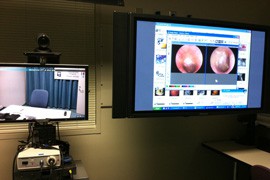Cronkite News has moved to a new home at cronkitenews.azpbs.org. Use this site to search archives from 2011 to May 2015. You can search the new site for current stories.
UA receives grant to expand telemedicine program
TUCSON – A $1.3 million federal grant will allow a University of Arizona center to expand a regional program helping hospitals and health care providers get into or make better use of telemedicine.
The Southwest Telehealth Resource Center, part of the Arizona Telemedicine Program and one of 14 regional centers around country, serves Arizona, Utah, Colorado, New Mexico and Nevada.
The resource center shares information on a variety of topics from technology to techniques for assessing patients remotely. It also offers educational modules.
The four-year grant, awarded by the U.S. Department of Health and Human Services’ Office for the Advancement of Telehealth, will allow the center to expand that mission, said Elizabeth Krupinski, its program director.
“We have the strategies down, so the next four years is going to allow us to provide more webinars and more training,” she said. “It also allows us to interact more with the other Telehealth Resource Centers.”
The ultimate goal, Krupinski said, is using telemedicine to expand patients’ access to care.
“What telemedicine does is provide quality care to anyone, anytime, anywhere,” she said. “It improves access to health care.”
Dr. Ronald Weinstein, director of the Arizona Telemedicine Program, said the grant will enable the center to enrich its offerings.
“There’s a real limit in how many areas you can be an expert in and be thinking constantly about curriculum development, education and training,” he said. “So what this ultimately does is allow individual sites to specialize and to share with a collaborator base. I would expect the quality and depth of materials goes up quite dramatically.”
Benson Hospital became a part of a teletrauma pilot program through the center in 2007 but now uses telemedicine mostly for nursing education, according to John “Rob” Roberts, director of information technology.
“We’re having a hard time with clinical buy-in for the programs,” he said. “It’s more of a workflow-type thing than a technology problem.”
But Weinstein listed many benefits of telemedicine: saving travel costs, reducing medical errors and decreasing what’s called fragmentation in services.
“So a woman who needs breast care might go to an imaging center and then may need a biopsy, which could easily be in a different health care system, and might need access to cancer doctors. That could be in a third health care system,” he said. “That might be four or five appointments, which could be totally uncoordinated.”
By creating a single admission for that woman, telemedicine would increase the quality of service and decrease her psychological trauma, Weinstein said.









